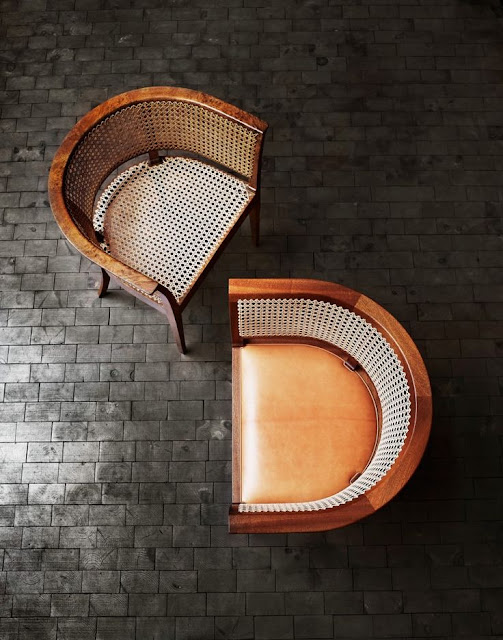"Kaare Klint was born in 1888 in Frederiksberg and designed his first furniture in 1914, for the Faaborg Museum, the Faaborg Chair. The chair was carefully designed to fulfill its intended function: A light, moveable armchair that museum visitors could easily place in front of the painting they wished to study in detail." (Source)
See Faaborg Museum below.
"The manufacturer, Rud. Rasmussen, has produced the chair since 1931. It was originally produced with a French canework seat, sides and back so as not to entirely obstruct the view of the gallery's beautiful mosaic floor.
Since 1964, the chair has been manufactured with a fixed padded seat, which can be upholstered in goat hide, oxhide, or fabric.
The chair is manufactured in mahogany, European cherry, ash, or oak, and comes with handwoven French canework on the sides and back. "
"Kaare Klint is known as the godfather of modern Danish design. As a member of the older generation, he was an influential founder and teacher at the furniture school of the Royal Academy (1924). There he helped create the fundamental approach and shape the views of some of most of renowned designers of the Danish Style." (Source)
"Klint’s designs appear very traditional-looking to our modern eye, and some are even a little clunky. That was refined by his successors, Ole Wanscher, Børge Mogensen, and some others. Poul Kjærholm was another; he worked in steel, marble, glass, and industrial materials." (Source)
See other works of Klint below.
"The period that is considered Danish Modern would be 1930 to 1970, but the real growth in the movement took off in the postwar period. Danish Modernism came about because of all that post-World War II growth and the need to supply goods for an expanding population."
"Did the Danish Modern movement parallel the Mid-century Modern movement, or were they pretty separate? They share roots in the 1930s and the Bauhaus, in the steel movement in Holland, and in similar movements in the U.S., but they were ultimately separate. Unlike designers in the rest of Europe, they weren’t throwing out historical form, by and large (like that of the Mid-century Modern). They still had a love of traditional materials. In America—we’ve always been the melting pot—you see the whole range. A lot of our American manufacturers overtly copied Danish design."
Check out these wonderful Danish Modern inspired spaces.
















No comments:
Post a Comment